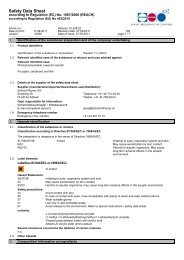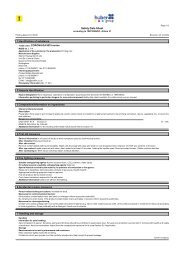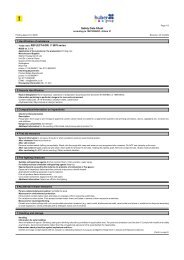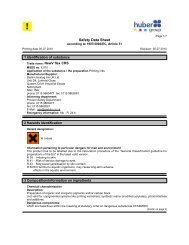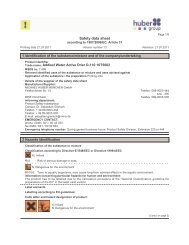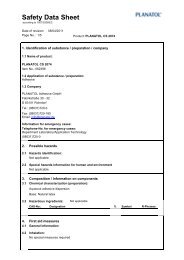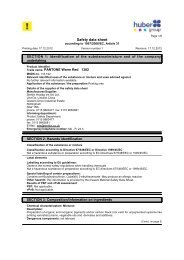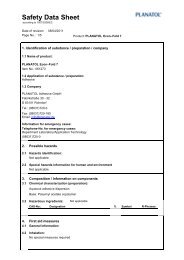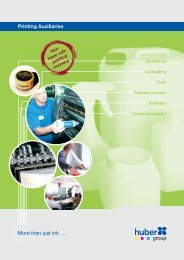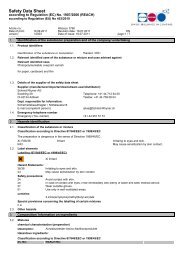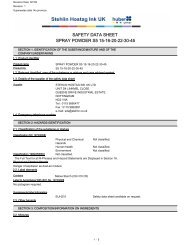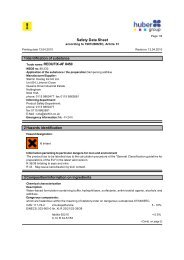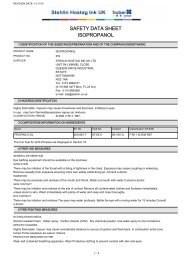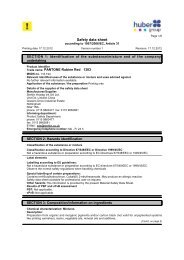Delta EDPM UV Wash D1080 - Stehlin Hostag UK
Delta EDPM UV Wash D1080 - Stehlin Hostag UK
Delta EDPM UV Wash D1080 - Stehlin Hostag UK
Create successful ePaper yourself
Turn your PDF publications into a flip-book with our unique Google optimized e-Paper software.
Revision Date 18/10/12<br />
Revision 23<br />
Supersedes date 10/5/10<br />
SAFETY DATA SHEET<br />
DELTA <strong>EDPM</strong> <strong>UV</strong> WASH<br />
SECTION 1: IDENTIFICATION OF THE SUBSTANCE/MIXTURE AND OF THE<br />
COMPANY/UNDERTAKING<br />
1.1. Product identifier<br />
Product name<br />
Product No.<br />
DELTA <strong>EDPM</strong> <strong>UV</strong> WASH<br />
<strong>D1080</strong><br />
1.2. Relevant identified uses of the substance or mixture and uses advised against<br />
Identified uses<br />
1.3. Details of the supplier of the safety data sheet<br />
BLANKET AND ROLLER WASH<br />
Supplier<br />
STEHLIN HOSTAG INK <strong>UK</strong> LTD<br />
UNIT D4 LINKMEL CLOSE<br />
QUEENS DRIVE INDUSTRIAL ESTATE<br />
NOTTINGHAM<br />
NG2 1NA<br />
Tel : 0115 9860477<br />
Fax : 0115 9862681<br />
e-mail: sds@stehlin.co.uk<br />
1.4. Emergency telephone number<br />
SECTION 2: HAZARDS IDENTIFICATION<br />
2.1. Classification of the substance or mixture<br />
Classification (EC 1272/2008)<br />
Classification (1999/45/EEC)<br />
Physical and Chemical<br />
Hazards<br />
Human health<br />
Environment<br />
Xn;R20/21/22. Xi;R36/38.<br />
Not classified.<br />
The Full Text for all R-Phrases and Hazard Statements are Displayed in Section 16.<br />
Human health<br />
Harmful by inhalation, in contact with skin and if swallowed. Irritating to eyes and skin.<br />
2.2. Label elements<br />
Contains<br />
Label In Accordance With (EC) No. 1272/2008<br />
2-BUTOXYETHANOL<br />
Acute Tox. 4 - H302;Acute Tox. 4 - H312;Acute Tox. 4 - H332;Skin<br />
Irrit. 2 - H315;Eye Irrit. 2 - H319<br />
Not classified.<br />
Signal Word<br />
Hazard Statements<br />
Warning<br />
H302<br />
H312<br />
H315<br />
Harmful if swallowed.<br />
Harmful in contact with skin.<br />
Causes skin irritation.<br />
1 / 6
Precautionary Statements<br />
H319<br />
H332<br />
P313<br />
Supplementary Precautionary Statements<br />
2.3. Other hazards<br />
P305+351+338<br />
P264<br />
P280<br />
P337<br />
This substance is not identified as a PBT substance.<br />
DELTA <strong>EDPM</strong> <strong>UV</strong> WASH<br />
SECTION 3: COMPOSITION/INFORMATION ON INGREDIENTS<br />
3.2. Mixtures<br />
Causes serious eye irritation.<br />
Harmful if inhaled.<br />
IF IN EYES: Rinse cautiously with water for several minutes.<br />
Remove contact lenses, if present and easy to do. Continue<br />
rinsing.<br />
Get medical advice/attention.<br />
<strong>Wash</strong> … thoroughly after handling.<br />
Wear protective gloves/protective clothing/eye protection/face<br />
protection.<br />
If eye irritation persists:<br />
2-BUTOXYETHANOL 90-93%<br />
CAS-No.: 111-76-2 EC No.: 203-905-0<br />
Classification (EC 1272/2008)<br />
Acute Tox. 4 - H302<br />
Acute Tox. 4 - H312<br />
Acute Tox. 4 - H332<br />
Skin Irrit. 2 - H315<br />
Eye Irrit. 2 - H319<br />
Classification (67/548/EEC)<br />
Xn;R20/21/22<br />
Xi;R36/38<br />
The Full Text for all R-Phrases and Hazard Statements are Displayed in Section 16.<br />
SECTION 4: FIRST AID MEASURES<br />
4.1. Description of first aid measures<br />
Inhalation<br />
There may be irritation of the throat with a feling of tightness in the chest. Remove casualty from exposure ensuring one's<br />
own safety whilst doing so. Consult a doctor<br />
Ingestion<br />
<strong>Wash</strong> out mouth with water DO NOT INDUCE VOMITING! If conscious, give half a litre of water to drink immediately.<br />
Consult a doctor.<br />
Skin contact<br />
Remove all contaminated clothes and footwear immediately, unless stuck to skin. Drench the affected skin with running<br />
water for 10 minutes or longer if substance if still on skin. Consult a doctor.<br />
Eye contact<br />
Bathe the eye with running water for 15 minutes Consult a doctor.<br />
4.2. Most important symptoms and effects, both acute and delayed<br />
General information<br />
Prolonged and repeated contact with solvents over a long period may lead to permanent health problems.<br />
Inhalation.<br />
Mild drowsiness or dizziness may occur. Droplets of the product aspirated into the lungs through ingestion or vomiting<br />
may cause a serious chemical pneumonia. Contains organic solvents which in case of overexposure may depress the<br />
central nervous system causing dizziness and intoxication.<br />
Ingestion<br />
Harmful: May cause lung damage if swallowed. Pneumonia may be the result if vomited material containing solvents<br />
reaches the lungs. There may be difficulty swallowing. Nausea and stomach pain may occur.<br />
Skin contact<br />
There may be irritation and redness at the site of contact. Repeated exposure may cause skin dryness or cracking<br />
2 / 6
Eye contact<br />
DELTA <strong>EDPM</strong> <strong>UV</strong> WASH<br />
There may be pain and redness. The eyes may water profusely.<br />
4.3. Indication of any immediate medical attention and special treatment needed<br />
Show this data sheet to the doctor in attendance. Eye bathing equipment should be available on the premises.<br />
SECTION 5: FIREFIGHTING MEASURES<br />
5.1. Extinguishing media<br />
Extinguishing media<br />
Carbon dioxide (CO2). Dry chemical powder. Foam. Do not use water jet as an extinguisher, as this will spread the fire.<br />
5.2. Special hazards arising from the substance or mixture<br />
Unusual Fire & Explosion Hazards<br />
In combustion emits toxic fumes<br />
5.3. Advice for firefighters<br />
Protective equipment for fire-fighters<br />
Wear self contained breathing apparatus. Wear Protective clothing to prevent contact with skin and eyes.<br />
SECTION 6: ACCIDENTAL RELEASE MEASURES<br />
6.1. Personal precautions, protective equipment and emergency procedures<br />
Refer to section 8 of SDS for personal protection details. Mark out the contaminated area with signs and prevent access to<br />
unauthorised personnel. Turn leaking containers leak-side up to prevent the escape of liquid.<br />
6.2. Environmental precautions<br />
Do not discharge into drains or rivers. Contain the spillage using bunding.<br />
6.3. Methods and material for containment and cleaning up<br />
Absorb into dry earth or sand. Transfer to a closable, labelled salvage container for disposal by an appropriate method.<br />
6.4. Reference to other sections<br />
See section 7 for information on safe Handling. See section 8 for information on personal protective equipment. See<br />
section 13 for disposal information.<br />
SECTION 7: HANDLING AND STORAGE<br />
7.1. Precautions for safe handling<br />
Avoid the formation or spread of mists in the air. Avoid direct contact with the substance.<br />
7.2. Conditions for safe storage, including any incompatibilities<br />
Store in cool, well ventilated place. Keep container closed when not in use. It is recommended to store in original<br />
packaging.<br />
7.3. Specific end use(s)<br />
Cleaning Solvent for Printers<br />
SECTION 8: EXPOSURE CONTROLS/PERSONAL PROTECTION<br />
8.1. Control parameters<br />
Name<br />
STD<br />
TWA - 8 Hrs<br />
STEL - 15 Min<br />
Notes<br />
2-BUTOXYETHANOL<br />
WEL 25<br />
50<br />
ppm(Sk)<br />
ppm(Sk)<br />
WEL = Workplace Exposure Limit.<br />
8.2. Exposure controls<br />
Engineering measures<br />
Ensure thers is sufficient ventilation of the area.<br />
Respiratory equipment<br />
Use suitable respiratory protective device in case of insufficient ventilation.<br />
3 / 6
Hand protection<br />
DELTA <strong>EDPM</strong> <strong>UV</strong> WASH<br />
Butyl rubber. Viton rubber (fluor rubber). Gloves should be replaced regularly or if any change in appearance is noticed.<br />
Ensure gloves are manufactured in accordance with BS EN 374. Penetration times carried out according to EN 34 part III<br />
are not always practicable, therefore maximum wearing time of 50% of penetration time is recommended.<br />
Eye protection<br />
Safety glasses with side-shields. Ensure eye bath is to hand.<br />
Skin protection<br />
Impermeable protective clothing<br />
Environmental Exposure Controls<br />
An environmental assessment must be made to ensure compliance with local environmental legislation.<br />
SECTION 9: PHYSICAL AND CHEMICAL PROPERTIES<br />
9.1. Information on basic physical and chemical properties<br />
Appearance<br />
Colour<br />
Odour<br />
Solubility<br />
Flash point<br />
9.2. Other information<br />
Liquid<br />
Colourless.<br />
Ether<br />
Soluble in water.<br />
>67 degrees C<br />
Not applicable<br />
SECTION 10: STABILITY AND REACTIVITY<br />
10.1. Reactivity<br />
Stable under recommended transport or storage conditions.<br />
10.2. Chemical stability<br />
Stable under normal conditions<br />
10.3. Possibility of hazardous reactions<br />
Hazardous reactions will not occur under normal transport or storage conditions. Decomposition may occur on exposure<br />
to conditions or materials listed below.<br />
10.4. Conditions to avoid<br />
Avoid heat.<br />
10.5. Incompatible materials<br />
Materials To Avoid<br />
Strong oxidising substances. Strong acids.<br />
10.6. Hazardous decomposition products<br />
In combustions emits toxic fumes<br />
SECTION 11: TOXICOLOGICAL INFORMATION<br />
11.1. Information on toxicological effects<br />
Toxicological information<br />
Acute toxicity (Hamful). Route INH DRM ING<br />
Skin Corrosion/Irritation:<br />
Effect: Irritation Route: OPT DRM Basis: Hazardous:Calculated<br />
Inhalation<br />
MIld drowsiness or dizziness may occur. Droplets of the product aspirated into the lungs through ingestion or vomiting<br />
may cause a serious chemical pneumonia. Contains organic solvents which in case of overexposure may depress the<br />
central nervous system causing dizziness and intoxication.<br />
4 / 6
DELTA <strong>EDPM</strong> <strong>UV</strong> WASH<br />
Ingestion<br />
Harmful: may cause lung damage if swallowed. Pneumonia may be the result if vomited material containing solvents<br />
reaches the lungs. There may be difficulty swallowing. Nausea and stomach pain may occur.<br />
Skin contact<br />
There may be irritation and redness at the site of contact Repeated exposure may cause skin dryness or cracking.<br />
Eye contact<br />
There may be pain and redness. The eyes may water profusely.<br />
Specific effects<br />
Prolonged and repeated contact with solvents over a long period may lead to permanent health problems.<br />
Toxicological information on ingredients.<br />
Toxic Dose 1 - LD 50<br />
1230 mg/kg (oral-mouse)<br />
Toxic Dose 2 - LD 50<br />
470 mg/kg (oral rat)<br />
Other Health Effects<br />
LD50 307 mg/kg IVN RAT<br />
2-BUTOXYETHANOL (CAS: 111-76-2)<br />
SECTION 12: ECOLOGICAL INFORMATION<br />
Ecotoxicity<br />
Not applicable.<br />
12.1. Toxicity<br />
12.2. Persistence and degradability<br />
Degradability<br />
Readily biodegradeable<br />
12.3. Bioaccumulative potential<br />
Bioaccumulative potential<br />
No bioaccumulation potential<br />
12.4. Mobility in soil<br />
Mobility:<br />
The product is soluble in water.<br />
12.5. Results of PBT and vPvB assessment<br />
This substance is not identified at a PBT substance<br />
12.6. Other adverse effects<br />
Negligible ecotoxicity<br />
SECTION 13: DISPOSAL CONSIDERATIONS<br />
13.1. Waste treatment methods<br />
Transfer to a suitable container and arrange for collection by specialised disposal company. NB: The user's attention is<br />
drawn to the possible existence of regional and antional regulations regarding disposal.<br />
SECTION 14: TRANSPORT INFORMATION<br />
General<br />
Not classified according to transport regulations for dangerous goods.<br />
14.1. UN number<br />
5 / 6
14.2. UN proper shipping name<br />
DELTA <strong>EDPM</strong> <strong>UV</strong> WASH<br />
14.3. Transport hazard class(es)<br />
14.4. Packing group<br />
14.5. Environmental hazards<br />
14.6. Special precautions for user<br />
14.7. Transport in bulk according to Annex II of MARPOL73/78 and the IBC Code<br />
SECTION 15: REGULATORY INFORMATION<br />
15.1. Safety, health and environmental regulations/legislation specific for the substance or mixture<br />
EU Legislation<br />
Regulation (EC) No 1907/2006 of the European Parliament and of the Council of 18 December 2006 concerning the<br />
Registration, Evaluation, Authorisation and Restriction of Chemicals (REACH), establishing a European Chemicals<br />
Agency, amending Directive 1999/45/EC and repealing Council Regulation (EEC) No 793/93 and Commission<br />
Regulation (EC) No 1488/94 as well as Council Directive 76/769/EEC and Commission Directives 91/155/EEC,<br />
93/67/EEC, 93/105/EC and 2000/21/EC, including amendments. Regulation (EC) No 1272/2008 of the European<br />
Parliament and of the Council of 16 December 2008 on classification, labelling and packaging of substances and<br />
mixtures, amending and repealing Directives 67/548/EEC and 1999/45/EC, and amending Regulation (EC) No<br />
1907/2006 with amendments.<br />
15.2. Chemical Safety Assessment<br />
A chemical safety assessment has not been carried out for the substance or the mixure by the supplier<br />
SECTION 16: OTHER INFORMATION<br />
Revision Comments<br />
NOTE: Lines within the margin indicate significant changes from the previous revision.<br />
Issued By<br />
B.A Hayden HSQE Manager<br />
Revision Date 18/10/12<br />
Revision 23<br />
Supersedes date 10/5/10<br />
SDS No. 10818<br />
Safety Data Sheet Status<br />
Approved.<br />
Date issued 18/10/12<br />
Risk Phrases In Full<br />
R20/21/22<br />
R36/38<br />
Hazard Statements In Full<br />
H302<br />
H312<br />
H315<br />
H319<br />
H332<br />
Harmful by inhalation, in contact with skin and if swallowed.<br />
Irritating to eyes and skin.<br />
Harmful if swallowed.<br />
Harmful in contact with skin.<br />
Causes skin irritation.<br />
Causes serious eye irritation.<br />
Harmful if inhaled.<br />
Disclaimer<br />
This information relates only to the specific material designated and may not be valid for such material used in combination with any other materials or<br />
in any process. Such information is, to the best of the company's knowledge and belief, accurate and reliable as of the date indicated. However, no<br />
warranty guarantee or representation is made to its accuracy, reliability or completeness. It is the user's responsibility to satisfy himself as to the<br />
suitability of such information for his own particular use.<br />
6 / 6




